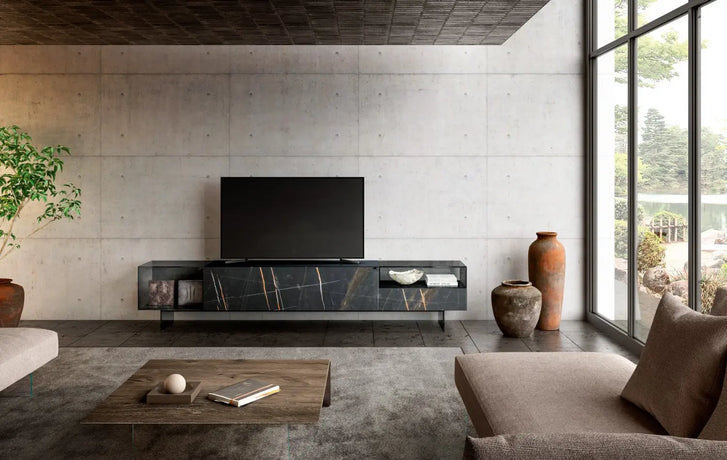- No products in the cart.
WALL MOUNTED TV UNITS: A COMPREHENSIVE GUIDE TO DESIGN, FUNCTIONALITY, AND STYLE
22
Aug
Introduction
In today's homes, where technology and aesthetics converge, the wall-mounted TV unit has emerged as a focal point in modern living spaces. More than just a place to display your television, these units serve as multifunctional pieces that enhance both the visual appeal and practicality of a room. From sleek, minimalist designs to elaborate, multifunctional setups, wall-mounted TV units are essential in contemporary interior design. This article delves deep into the world of wall-mounted TV units, exploring their evolution, design possibilities, functional benefits, and tips for selecting and installing the perfect unit for your home.
The Evolution of Wall-Mounted TV Units
The Early Days of Television and Furniture
The journey of the wall-mounted TV unit begins with the evolution of the television itself. In the early days of television, the sets were bulky and heavy, housed in large, ornate cabinets that were as much furniture as they were electronic devices. These cabinets were designed to blend into the room, often featuring decorative woodwork and storage space for other electronics or media.
The Transition to Wall Mounting
As technology advanced, televisions became slimmer and lighter, paving the way for wall-mounted TV units. The shift from bulky cabinets to sleek, wall-mounted designs was driven by the desire for more space-efficient living and a cleaner aesthetic. By the early 2000s, flat-screen televisions became widely accessible, and the concept of wall-mounted units started gaining popularity. These units not only saved space but also allowed homeowners to elevate their interior design by creating a more streamlined look.
Modern Wall-Mounted TV Units
Today, wall-mounted TV units have evolved into highly customizable pieces of furniture that cater to a variety of tastes and needs. They range from minimalist floating shelves to complex systems with built-in storage, lighting, and even integrated sound systems. The modern wall-mounted TV unit is as much about enhancing the room's decor as it is about providing a functional space for your entertainment needs.
Design Considerations for Wall-Mounted TV Units
Assessing Your Space
Before selecting a wall-mounted TV unit, it’s crucial to assess the space where it will be installed. Consider the size of the room, the layout, and the wall space available. The placement of your TV will also determine how you interact with other elements in the room, such as seating, lighting, and traffic flow.
- Room Size: For smaller rooms, a minimalist design that doesn’t overwhelm the space is ideal. Conversely, larger rooms can accommodate more elaborate units with additional features like shelving, storage, or even a fireplace.
- Viewing Distance: The size of the TV and the distance from the seating area should be balanced. A general rule of thumb is to place the TV at a distance that is about 1.5 to 2.5 times the diagonal size of the screen.
Style and Aesthetic
Wall-mounted TV units come in a variety of styles to match different interior design themes. Whether your home leans towards modern, traditional, industrial, or eclectic, there’s a unit that can complement your decor.
- Modern/Minimalist: Sleek, clean lines with minimal adornment characterize modern TV units. Materials like glass, metal, and lacquered wood are common in this style. The focus is on functionality and simplicity.
- Traditional: Traditional TV units may feature more ornate designs, with detailed woodwork and a variety of finishes like mahogany or walnut. These units often blend in with other traditional furniture pieces.
- Industrial: For a more rugged look, industrial-style units often incorporate materials like exposed metal, reclaimed wood, and concrete. These designs are sturdy and offer a mix of raw aesthetics and practical storage.
- Eclectic: Eclectic designs mix different materials, colors, and textures to create a unique piece. These units are ideal for those who want to make a bold statement in their living space.
Materials and Finishes
The materials and finishes of a wall-mounted TV unit significantly impact its durability, appearance, and how well it blends with your existing decor. Some common materials include:
- Wood: A classic choice, wood provides warmth and timeless appeal. Solid wood units are durable and can be stained or painted to match any decor.
- MDF (Medium-Density Fiberboard): A more affordable alternative to solid wood, MDF can be finished with veneers or laminates to mimic the appearance of natural wood.
- Glass: Glass shelves or panels add a touch of modern elegance. However, they require more maintenance to keep clean and free of fingerprints.
- Metal: Often used in contemporary and industrial designs, metal offers durability and a sleek appearance. It is commonly used for brackets, frames, or accents.
- Laminate: An economical and versatile material, laminate can be made to resemble wood, stone, or other finishes while being easy to clean and maintain.
Functionality and Features
A well-designed wall-mounted TV unit should not only look good but also offer practical features that enhance your viewing experience and organization.
- Storage: Consider how much storage space you need for media devices, game consoles, DVDs, or books. Units can feature open shelves, cabinets with doors, or even drawers to keep everything neatly organized.
- Cable Management: A key feature of modern TV units is effective cable management. This helps to hide unsightly wires and keeps your setup looking tidy. Look for units with built-in channels or compartments to route cables out of sight.
- Integrated Lighting: Some TV units come with built-in lighting, which can add ambiance to your space. LED strips behind the TV or within shelves can create a soft glow that enhances the viewing experience.
- Sound System Integration: If you have a home theater system, consider a unit that allows for easy integration of speakers and subwoofers. Some units even come with built-in soundbars or surround sound systems.
The Benefits of Wall-Mounted TV Units
Space Efficiency
One of the primary benefits of a wall-mounted TV unit is the efficient use of space. By mounting the TV on the wall, you free up floor space, making the room feel larger and less cluttered. This is particularly beneficial in smaller living spaces, such as apartments or studios, where every square foot counts.
Improved Viewing Experience
Wall-mounted TV units allow you to position your television at the perfect height for comfortable viewing. Ideally, the center of the screen should be at eye level when you’re seated. This setup reduces neck strain and makes for a more enjoyable viewing experience.
Enhanced Aesthetic Appeal
A well-chosen wall-mounted TV unit can serve as a centerpiece in your living room, tying together the overall decor. Whether you opt for a minimalist design that blends into the background or a bold statement piece, the right unit can elevate the look of your space.
Organization and Clutter Reduction
Modern TV units are designed with organization in mind. With designated spaces for all your media equipment, accessories, and even decorative items, these units help keep your living space tidy and free of clutter. Cable management systems further enhance this by concealing wires and cables, giving your setup a clean and streamlined appearance.
Safety and Child-Proofing
Mounting your TV on the wall can also be a safety feature, particularly in homes with young children or pets. Wall-mounted units reduce the risk of the TV being knocked over or pulled down, which can prevent accidents and injuries.
Choosing the Right Wall-Mounted TV Unit for Your Home
Determine Your Needs
Before selecting a wall-mounted TV unit, it’s important to assess your specific needs. Consider the following questions:
- What is the size of your TV? The unit you choose must be able to support the size and weight of your television.
- How much storage do you need? Determine what you need to store—whether it’s media devices, DVDs, gaming consoles, or decorative items—and choose a unit that offers adequate storage options.
- What is your budget? Wall-mounted TV units come in a wide range of prices. Set a budget that allows you to get the features you need without compromising on quality.
Measure Your Space
Accurate measurements are crucial when selecting a wall-mounted TV unit. Measure the width, height, and depth of the wall space where you plan to install the unit. Make sure to leave enough room around the TV for ventilation and access to cables.
Also, consider the height at which the TV will be mounted. The optimal height for the TV screen is typically at eye level when seated, which is usually about 42 to 48 inches from the floor to the center of the screen. However, this can vary based on personal preference and the height of your seating.
Consider the Weight Capacity
When selecting a wall-mounted TV unit, ensure that it has the appropriate weight capacity for your television. This includes the weight of the TV itself, as well as any additional components or decorations that will be placed on the unit. Overloading the unit can compromise its stability and safety.
Style and Compatibility
Choose a wall-mounted TV unit that complements the existing style of your home. The unit should blend seamlessly with your decor while also making the TV a focal point. If your home has a modern aesthetic, opt for a sleek and minimalist unit. For a more traditional space, consider a unit with rich wood finishes and classic design elements.
Compatibility with your TV is also important. Ensure that the mounting brackets on the unit match the VESA (Video Electronics Standards Association) mounting pattern on the back of your television. Most modern TVs and mounts adhere to VESA standards, but it’s always a good idea to double-check.
Installation Requirements
Consider the installation requirements for your chosen wall-mounted TV unit. Some units may require professional installation, especially if they involve complex wiring, heavy mounting, or integration with other systems like lighting or sound. If you’re comfortable with DIY projects, you might opt for a unit that comes with clear instructions and the necessary hardware.
Future-Proofing Your TV Unit
Technology evolves rapidly, and your wall-mounted TV unit should be able to accommodate future changes. Consider the following aspects to future-proof your unit:
- Size Flexibility: Choose a unit that can accommodate larger TV sizes. As new models with bigger screens become more affordable, having a unit that can adapt to a larger television ensures that you won’t need to replace the entire setup.
- Cable Management: Opt for a unit with ample cable management options. As you add or upgrade devices, such as streaming boxes, gaming consoles, or sound systems, you’ll need a way to manage the additional cables without cluttering the space.
- Modular Design: Some TV units offer modular components that can be rearranged or expanded over time. This flexibility allows you to customize the unit as your needs evolve, such as adding more storage or changing the configuration to accommodate new technology.
Installation Tips for Wall-Mounted TV Units
Step-by-Step Installation Guide
Installing a wall-mounted TV unit requires careful planning and execution. Here’s a step-by-step guide to help you through the process:
- Plan the Layout:
- Decide on the exact location where you want to mount the TV and the unit.
- Consider the height, viewing angles, and proximity to power outlets and other devices.
- Gather Tools and Materials:
- Ensure you have all necessary tools, such as a stud finder, level, drill, screws, and anchors.
- Prepare the mounting brackets and any additional hardware that came with the unit.
- Locate the Wall Studs:
- Use a stud finder to locate the wall studs. These are essential for securely mounting the TV and unit.
- Mark the positions of the studs with a pencil.
- Attach the Mounting Brackets:
- Follow the manufacturer’s instructions to attach the mounting brackets to the wall and the back of the TV.
- Use a level to ensure that the brackets are straight.
- Mount the TV and Unit:
- With the help of another person, carefully lift the TV and attach it to the wall-mounted brackets.
- Ensure that the unit is securely fastened and level.
- Connect the Devices:
- Attach any necessary cables and wires to your TV and other devices.
- Use the cable management features of your unit to hide and organize the cables.
- Final Adjustments:
- Make any final adjustments to the positioning of the TV and unit.
- Double-check the stability of the installation to ensure everything is secure.
Common Installation Mistakes to Avoid
While installing a wall-mounted TV unit, some common mistakes can compromise the safety and functionality of your setup. Here’s what to watch out for:
- Ignoring Wall Studs: Mounting a heavy TV and unit on drywall alone is a common mistake that can lead to accidents. Always anchor the unit to wall studs to ensure it can support the weight.
- Incorrect Height: Mounting the TV too high or too low can lead to uncomfortable viewing angles. As a guideline, the center of the screen should be at eye level when you’re seated.
- Poor Cable Management: Failing to organize cables can result in a messy appearance and potential safety hazards. Utilize the unit’s cable management features to keep everything neat.
- Overloading the Unit: Exceeding the weight capacity of the unit can cause it to fail. Be mindful of the weight limits and distribute the load evenly.
- Rushing the Installation: Take your time during the installation process. Rushing can lead to mistakes that may require reinstallation or, worse, damage to your wall or TV.
Integrating Wall-Mounted TV Units with Smart Home Technology
Smart Home Integration
As smart home technology becomes more prevalent, integrating your wall-mounted TV unit with these systems can enhance your entertainment experience. Here are some ways to incorporate smart technology:
- Voice Control: Integrate your TV unit with voice assistants like Amazon Alexa, Google Assistant, or Apple’s Siri. This allows you to control the TV, lighting, and even sound systems with voice commands, adding convenience to your setup.
- Smart Lighting: Install smart lighting around your TV unit that can be controlled remotely or programmed to change based on the content you’re watching. For instance, lights can dim when you start a movie or change color to match the mood of the scene.
- Automated Sound Systems: Pair your TV unit with a smart sound system that adjusts volume or sound settings based on the type of content being played. These systems can also integrate with voice assistants for seamless control.
- Universal Remote Systems: Consider a universal remote or a smart hub that consolidates the control of all your devices into one app or remote. This simplifies the operation of multiple devices, such as your TV, sound system, and streaming devices.
Future-Proofing with Smart Home Features
As technology continues to advance, preparing your wall-mounted TV unit for future innovations is wise. Here’s how you can future-proof your unit with smart home features:
- Upgradable Components: Choose a unit that allows for easy upgrading of components like speakers, lights, or even the mounting brackets. This ensures that you can incorporate new technology without needing to replace the entire unit.
- Flexible Connectivity: Ensure that your unit has ample space and options for connecting various smart devices. HDMI, USB, and wireless connections should be easily accessible and sufficient in number to accommodate future gadgets.
- Energy Efficiency: Consider smart power strips or energy-saving devices integrated with your TV unit. These can automatically turn off devices when not in use or optimize energy consumption, which is both eco-friendly and cost-effective.
Trends in Wall-Mounted TV Units
Minimalism and Floating Designs
Minimalist designs continue to dominate the market, with floating TV units being a popular choice. These designs emphasize clean lines, simplicity, and functionality without sacrificing style. Floating units give the illusion of more space by keeping the floor clear, and they often feature hidden storage compartments that maintain a clutter-free environment.
Multi-Functional Units
As living spaces become more compact, there’s a growing demand for multi-functional furniture. Wall-mounted TV units now often include features like integrated desks, workspaces, or even fold-out beds. These units maximize the utility of a single piece of furniture, making them ideal for small apartments or multifunctional living rooms.
Sustainable Materials
With increasing awareness of environmental sustainability, many homeowners are opting for TV units made from eco-friendly materials. Reclaimed wood, bamboo, and recycled materials are becoming more common in the design of wall-mounted units. These materials not only reduce environmental impact but also add a unique, natural aesthetic to the home.
Customization and Personalization
The trend towards customization continues to grow, with more homeowners seeking TV units that reflect their personal style and meet their specific needs. Modular units that can be configured in various ways or custom-built units that incorporate personal preferences are increasingly popular. This allows for a high degree of personalization, ensuring that the unit fits perfectly with the homeowner's lifestyle and decor.
Conclusion
Wall-mounted TV units have become an essential element in modern home design, offering a blend of functionality, style, and technological integration. As we’ve explored, the right TV unit can enhance your living space, improve your viewing experience, and even contribute to the overall value of your home. Whether you’re drawn to minimalist designs, need a multi-functional solution for a small space, or want to integrate smart home technology, there’s a wall-mounted TV unit that meets your needs.
Choosing the perfect wall-mounted TV unit involves careful consideration of your space, style preferences, and functional requirements. By assessing your needs, planning the layout, and paying attention to installation details, you can create a setup that not only looks great but also enhances your everyday life.
As trends continue to evolve, wall-mounted TV units will likely incorporate even more advanced features and materials, further cementing their place as a cornerstone of modern interior design. Whether you’re updating an existing space or designing a new one, investing in a high-quality, well-planned TV unit is a decision that will provide lasting benefits, both aesthetically and functionally.













